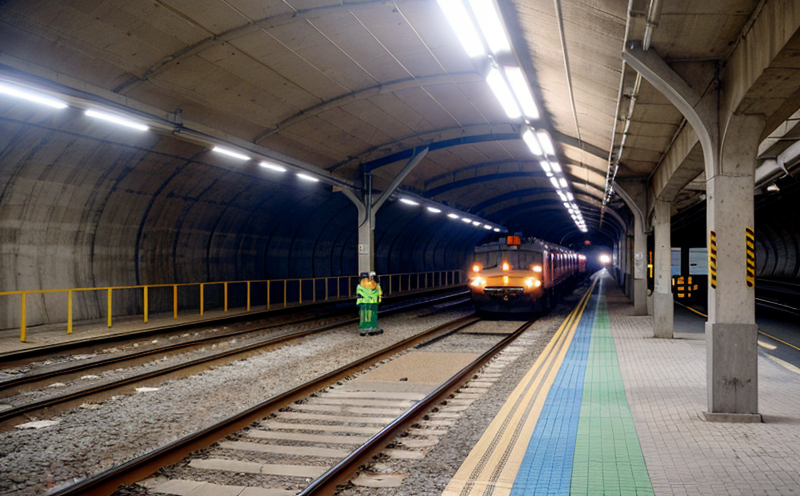EN 1363 Fire Resistance Testing of Tunnel Structures
The European Standard EN 1363-1 specifies the fire resistance testing procedures for tunnel structures, which are critical components in railway and transportation infrastructure. These tunnels serve as vital transport corridors connecting cities, regions, and countries across Europe. The safety and durability of such structures are paramount, especially considering the high volume of traffic they handle.
The standard ensures that tunnel structures can withstand the intense heat generated during a fire event without collapsing or failing in a manner that could endanger lives or cause significant property damage. This is particularly important given the enclosed nature of tunnels and their potential to rapidly spread smoke, flames, and toxic gases if not properly tested and constructed.
The testing procedure outlined in EN 1363-1 involves subjecting representative specimens of tunnel structural elements to controlled fire exposure conditions. The test setup includes a furnace that can simulate the type of fire expected in real-world scenarios, typically involving hydrocarbon flames or equivalent heat sources. The specimen is exposed to these conditions for specified durations and at defined temperatures.
The primary objective of this testing is to evaluate how well the tunnel structure resists deformation, loss of load-bearing capacity, and structural integrity under fire exposure. This includes assessing the performance of materials like concrete, steel, and composite structures that make up the tunnel walls, roofs, and floors.
Real-world usage notes indicate that tunnels in Europe are often exposed to different types of fires depending on their location and function. For instance, tunnels beneath urban areas may face fires originating from vehicles or infrastructure failures, while those in rural settings might encounter wildfires. Understanding these contextual factors is crucial for selecting appropriate materials and implementing effective fire safety measures.
The testing process also evaluates the effectiveness of fire protection systems installed within the tunnel structures. This includes sprinkler systems, smoke detection devices, and other passive and active fire protection measures that are integral to ensuring passenger and staff safety during emergencies. The results from EN 1363-1 tests provide critical data for improving these systems and enhancing overall safety standards.
Furthermore, the standard emphasizes the importance of selecting materials with high thermal stability and low combustibility properties. Concrete, for example, is widely used in tunnel construction due to its excellent fire resistance capabilities when properly designed and reinforced. Steel, another common material, requires careful attention to detail during fabrication and installation to prevent premature failure under extreme heat conditions.
The EN 1363-1 testing protocol ensures that all stakeholders involved in railway and transportation infrastructure projects adhere to stringent quality control measures. This not only enhances public safety but also contributes significantly to the longevity and sustainability of these vital assets. By adhering to this standard, engineers and constructors can ensure that their designs meet the highest international benchmarks for fire resistance in tunnel structures.
Scope and Methodology
The scope of EN 1363-1 testing is limited to evaluating the fire resistance properties of structural elements within railway tunnels. This includes walls, roofs, floors, columns, and any other components that contribute to the overall stability and safety of the tunnel structure.
The methodology involves several key steps:
- Selection of appropriate specimens representing typical tunnel construction materials and configurations.
- Exposure of these specimens to controlled fire conditions in a laboratory setting.
- Evaluation of the structural integrity, deformation levels, and material performance during and after exposure.
The test setup typically includes a furnace that can simulate various types of fires, along with precise temperature control systems. Specimens are placed inside the furnace for predetermined durations to observe how they perform under high-temperature conditions. After testing, detailed assessments are conducted to determine compliance with specified criteria.
Benefits
- Ensures compliance with international fire safety standards, thereby enhancing public trust and confidence in railway infrastructure projects.
- Reduces the risk of tunnel collapse during fires, protecting lives and minimizing potential damage to assets.
- Provides valuable data for improving fire protection systems within tunnels, leading to more effective emergency response strategies.
- Supports sustainable design practices by encouraging the use of durable materials with superior thermal stability properties.
- Aids in identifying areas for improvement in tunnel construction techniques and material selection based on real-world testing data.





